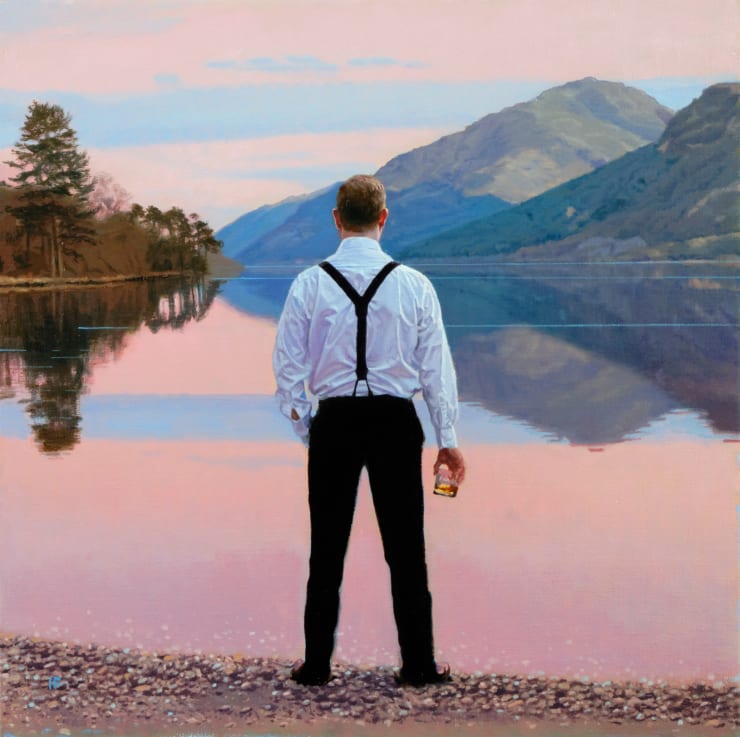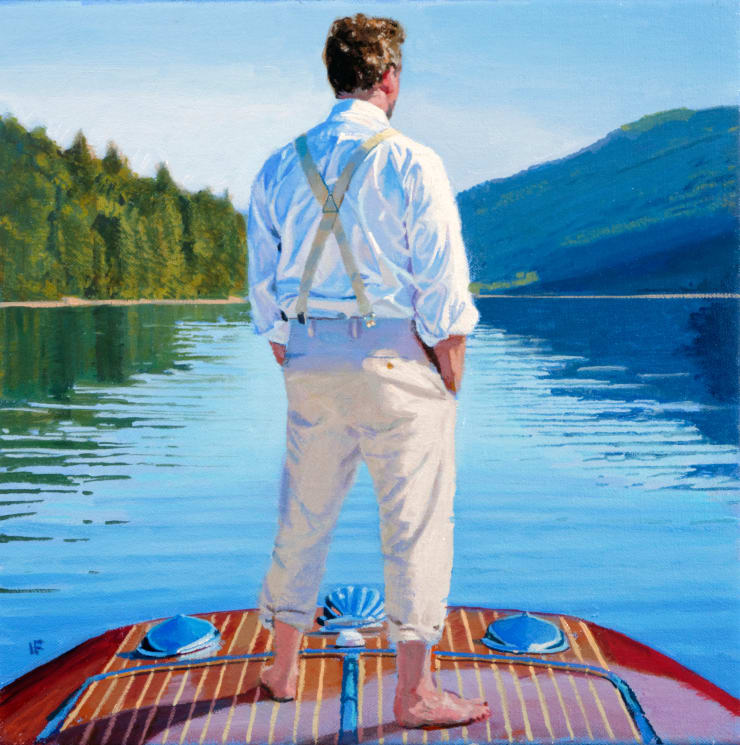Iain Faulkner: Voyager
Albemarle Gallery is excited to announce a new solo show by the acclaimed Scottish painter Iain Faulkner. Faulkner’s enquiry into the male image continues with a suite of new paintings which locate his subject in dramatic Scottish landscape. These scenes are set on and around water. Faulkner’s protagonist is shown at the helm of a speedboat or standing contemplating the waters. We view him from behind. We see what he sees and join him in anticipation of a journey ahead.
Faulkner deploys his trademark skill and assured fluency of technique in making these images. He describes the play of light across sea, forest and land; the spume, spray and mist of turbulent water; the subtly-various textures of cloth, polished wood and chrome. His is a painstaking and thorough approach, where all that is seen is analysed, measured and distilled down to its pictorial essence.
The landscape looms large, expressive of a Romantic sensibility that prompts an emotional response. Faulkner's deft treatment of colour, atmospheric effect and aerial perspective conveys a sense of monumental and expansive space, within which his hero asserts himself. We can see correspondences to a broad tradition of Scottish landscape painting, which locks into a profound sense of place and belonging. The boat, immersed in this grandeur and guided by its pilot, carves out a path through the sparkling waters, throwing out a foaming, churning backwash. Our viewpoint is literally in the voyager's wake. He leads and we follow.
The depiction of an autonomous and independent male engaged in an undetermined quest is typical of this artist. It is a trope that he returns to throughout his career and sits at the thematic heart of his practice. Faulkner's vital and capable helmsman moves alone through the world, exploring its possibilities. These paintings are an elegy for such adventurers and suggest a nostalgia for an idea of 'modernity' that is currently under threat.
FOR SALES & PRESS ENQUIRIES
Please email us here or get in touch on WhatsApp.
-
 Late Winter, Whistlefield Jetty, 2022Oil on canvas40.6 x 40.6 cm
Late Winter, Whistlefield Jetty, 2022Oil on canvas40.6 x 40.6 cm
16 x 16 in -
 Mist and Wake, Loch Eck, 2022Oil on canvas121.9 x 121.9 cm
Mist and Wake, Loch Eck, 2022Oil on canvas121.9 x 121.9 cm
48 x 48 in -
 Morning Mist, Loch Eck, 2022Oil on canvas76.2 x 76.2 cm
Morning Mist, Loch Eck, 2022Oil on canvas76.2 x 76.2 cm
30 x 30 in -
 Pink and Amber, 2022Oil on canvas50.8 x 50.8 cm
Pink and Amber, 2022Oil on canvas50.8 x 50.8 cm
20 x 20 in -
 Small Wake, 2022Oil on canvas30.5 x 30.5 cm
Small Wake, 2022Oil on canvas30.5 x 30.5 cm
12 x 12 in -
 Small Warming Sun, 2022Oil on canvas30.5 x 30.5 cm
Small Warming Sun, 2022Oil on canvas30.5 x 30.5 cm
12 x 12 in -
 Summer Morning, Loch Eck, 2022Oil on canvas121.9 x 121.9 cm
Summer Morning, Loch Eck, 2022Oil on canvas121.9 x 121.9 cm
48 x 48 in -
 Sunset, Loch Earn, 2022Oil on canvas76.2 x 76.2 cm
Sunset, Loch Earn, 2022Oil on canvas76.2 x 76.2 cm
30 x 30 in -
 Thaw, 2022Oil on canvas76.2 x 76.2 cm
Thaw, 2022Oil on canvas76.2 x 76.2 cm
30 x 30 in -
 Wake, 2022Oil on canvas91.4 x 91.4 cm
Wake, 2022Oil on canvas91.4 x 91.4 cm
36 x 36 in -
 Iain Faulkner, Wake II, Loch Eck, 2022
Iain Faulkner, Wake II, Loch Eck, 2022 -
 Warm Sun, Winter, 2022Oil on canvas91.4 x 91.4 cm
Warm Sun, Winter, 2022Oil on canvas91.4 x 91.4 cm
36 x 36 in -
 Warming Sun, 2022Oil on canvas91.4 x 91.4 cm
Warming Sun, 2022Oil on canvas91.4 x 91.4 cm
36 x 36 in -
 Winter dram, Jubilee Point, 2022Oil on canvas76.2 x 76.2 cm
Winter dram, Jubilee Point, 2022Oil on canvas76.2 x 76.2 cm
30 x 30 in















